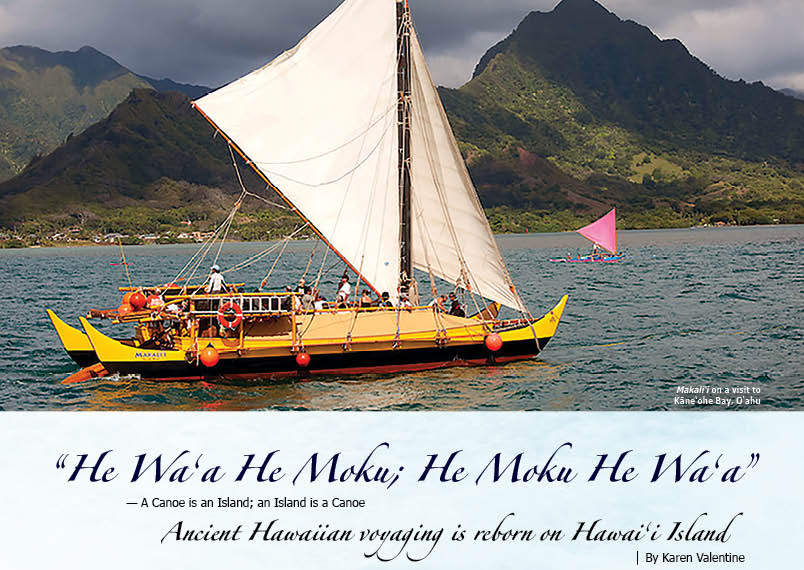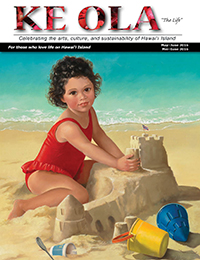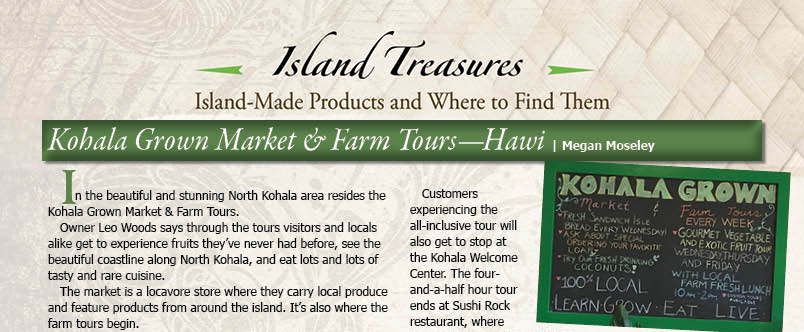
“He Wa‘a He Moku; He Moku He Wa‘a” (A Canoe Is an Island; an Island Is a Canoe): Ancient Hawaiian Voyaging is Reborn on Hawai‘i Island
By Karen Valentine
In each ‘ohana (family), there are those who are called to the sea and those to whom the ‘āina (land) speaks, so they plant the food and the trees that help sustain everyone, including those who choose to fish and travel the ocean highways to distant lands on wa‘a kaulua (voyaging canoes).
In the 1970s, a renaissance of native Hawaiian culture began, including the knowledge and wisdom of long ocean voyages. It resulted in the founding of the Polynesian Voyaging Society with the inspiration of Hawaiian artist Herb Kawainui Kāne, who drew a schematic of a Hawaiian voyaging canoe. It was to become one that would be large enough to circumnavigate the globe and carry enough crew and supplies to sustain them. The Hōkūle‘a was built, staffed, and provisioned to make its first voyage to Tahiti in 1976.
Chadd Ka‘onohi Paishon, who today makes his home here in Kohala, was there from the beginning when, as a child, he lived on O‘ahu’s west side.
“Back in the ‘60s, my grandmother told me stories about our kūpuna (elders) traveling in voyaging canoes and the stories always fascinated me,” recalls Chadd. “In the third grade, we got picked to go with this Hawaiian man who was doing children’s books about Hawai‘i. He chose me and four of my friends as models for his book. The man was Herb Kāne. We just played as he made sketches. I was fascinated by this pencil drawing of a sailing canoe in his studio. I asked my dad if he could give me the picture and he did. To me it was proof that what my grandmother told me was true. It’s still on my dad’s wall in Nānākuli. Later I heard about Hōkūle‘a being launched. I was a young man, and those guys were my idols. I thought some day I could maybe dive in the water and touch it. It turned out that one of my good friends had a connection with Hōkūle‘a, and I was invited to try out for future crew.”
Fast forward and today Chadd is a master navigator for Hōkūle‘a and its offspring vessels. He studied under its first navigator, Nainoa Thompson and has covered thousands of miles of ocean, built wa‘a kaulua and now is captain of Hawai‘i Island’s own voyaging canoe and voyaging society, Nā Kālai Wa‘a.

Sadly, back in the ‘70s when Herb Kāne and friends had the vision to build and sail the canoe, there was no Hawaiian still alive who knew the ancient skills of ocean navigation. A search went out to other Pacific islands, resulting in the discovery of Pius Mau Piailug, a Micronesian from the island of Satawal whose education had begun as a toddler under his grandfather, one of the last master ocean navigators. He knew how to navigate by the sun, the moon and the stars; by his reading of the winds, the clouds, the currents and ocean swells; and by the behavior of the birds and marine life. He observed the relationship of all these clues that the natural world offers to guide you to landfall.
Fortunately, Mau was up to the task of mentoring the Hawaiians who wanted to learn. It became the work for the remainder of his life, some 40 years. He taught them navigation and so much more, in the process endearing himself to his eager students, who came to call him “Papa Mau.”
“The guiding principle we learned from Mau,” says Chadd, “is that the canoe is our mother, the navigator is your father. Everyone standing on the deck is ‘ohana.”
Papa Mau navigated Hōkūle‘a on its maiden voyage to Tahiti in 1976, taking along apprentice navigators, including the first one, Milton “Shorty” Bertelmann from Waimea. Shorty is one of two brothers, who although from a paniolo family, were drawn by the sea and the dream of sailing the wa‘a kaulua. His older brother Clay quickly rose in the ranks to Captain of Hōkūle‘a.
Chadd Paishon also joined the Polynesian Voyaging Society in the apprentice navigator program in 1990. He participated in the repair and maintenance work on Hōkūle‘a in Honolulu and became a crew member along with Shorty and Clay on the 1992 leg to Tahiti.
During that voyage, gazing out over the vast ocean, Clay Bertelmann formulated his own dream, a dream about a canoe for his moku (island), Hawai‘i Island, so that his ‘ohana and his community could learn the principle of “He wa‘a he moku; He moku he wa‘a”: a canoe is an island; an island is a canoe. In other words, on the sea the canoe operates as a whole community, sustaining its people as an island sustains a community. On the canoe, the crew must work together as a team as a matter of life and death. It’s the same as on land, only much intensified. After training on the canoe, people come back changed and with a higher purpose, says Chadd. They have learned how to act responsibly on a communal level and how to mālama (care for) our finite natural and human resources of Hawai‘i.
After Hōkūle‘a, other islands launched their own programs. A hui (association) of voyaging canoes called ‘ohana wa‘a was formed, says Chadd. “Ours was the first canoe built outside of O‘ahu. It was radical in a sense, because everything had always been done in Honolulu. Clay wanted to continue the tradition of what Hōkūle‘a had done, but bring it closer to our community. When we did it here, it inspired others.”
The Hawai‘i Island canoe was named after the star cluster known as the Makali‘i (Pleiades).
In Clay’s dream, the canoe’s main purpose was to be an educational tool for the voyaging tradition and culture to be continued for generation after generation. Nā Kālai Wa‘a Moku o Hawai‘i, a nonprofit voyaging and educational organization was established in Waimea in March 1993, “to preserve, protect, and perpetuate Hawaiian culture and contribute to a safe and healthy future for Hawai‘i.”
Nā Kālai Wa‘a means “the canoe carvers” in its literal sense, and also the carvers of a tradition.
He wisely realized that it is not enough to be an example of this special lifestyle, but in order to ensure its continuance, the lifestyle needed to be extended into the communities through the platform of education. As it happened, Clay passed away too soon, in 2004, but he had laid the foundation.
Mauloa, the First Canoe
When the Bertelmann brothers approached Papa Mau about building another canoe, they were instructed to first build one strictly in the traditional manner. That meant that Hawaiian spiritual protocol had to be followed and all tools and all materials had to come from the island.
“The tools that we used to build the canoe were made of stone from the adze quarry on Mauna Kea,” says Chadd. “Everything we used was in the same traditions as our kūpuna. So we came to understand what we had to do from building this one. We learned how we had to go back to our forest and replant for future generations.”
From this charge, Mauloa was born in 1993—a single-hulled, coastal fishing canoe made entirely of natural materials traditionally utilized for canoe construction.
Mike Manu, an apprentice navigator, recently shared with keiki visiting from the Hawaiian immersion school Kanu o ka ‘Āina, about the building of Mauloa. “When looking for a tree to cut,” he says, “we tried to do it with protocol as our ancestors would have, as much as possible. We told the koa tree why we wanted to cut it down. To us, the tree is alive, a living spirit. So you have to ask the tree, a child of the forest, to become a child of the sea. We went to Mauna Kea to find the stones to make the adze for carving. We used native plants such as ‘ulu (breadfruit) for sap, lauhala (Pandanus) to make the sail, niu (coconut) for rope. The hull is made of koa estimated to be 200 years old. Other wood is hau (Hibiscus tiliaceus), light and strong, for other parts. A lot of the people here were there then, helping with Papa Mau.”
Several children in the class raised their hands and shared that their parents or grandparents were there.
Mauloa is still maintained and used for teaching.
It Takes a Village to Build a Canoe
In 1994, Clay Bertelmann approached Parker Ranch seeking support for the construction of a 54-foot double-hulled voyaging canoe for the local community. They provided a Quonset hut near Waimea town.
The inspiration and the passion was so strong that the entire paniolo community came out to help build Makali‘i.
Chadd was invited to come from O‘ahu and help, using his expertise learned on the Hōkūle‘a. “Clay called me to be part of the lashing crew.” As a result, he moved to this island and ended up marrying Clay’s daughter, Pomai, who also sails as a crew member and apprentice navigator. She is also a director of Nā Kālai Wa‘a.
From the beginning women have been a significant proportion of the voyaging crew as well as construction crew. Patty Solomon comes from a multi-generation Kohala family who are respected kūpuna in the area where Makali‘i has its home berth. They are caretakers for a navigational heiau located near Māhukona. “I was here when they built Makali‘i and worked on other canoes,” says Patty. “My grandfather learned the art of navigation but didn’t do it; he had to farm. After all these generations, I was the one who went to sea on the canoes. I was one of two wahine to sail back from Tahiti. I went to Micronesia twice, to Mau’s island, returning him home, and also on Hōkūle‘a to Japan.” Patty now works for Surety Kohala Corporation, owner of the land at Māhukona where the Makali‘i is currently under restoration, and volunteers with major tasks like fiberglassing.
After nine months of construction and work by many hands in the community, Makali‘i emerged from her Quonset hut birthplace.
“You had all these local families involved: the Puhis, the Case family, the Solomans and the Pa‘aluas,” says Chadd. “There was a great outpouring of community including kūpuna like Aunty Marie Soloman, Uncle Sonny Soloman, Robert Keakealani, Clarence Mederios, and Mau Piailug,” he recalls.
Other Hōkūle‘a veterans also came to Kohala to pitch in.
“For each person who stands on the deck of the canoe, there’s at least 100 people supporting that one. We know that when we leave Hawai‘i, we leave with the support of all our community,” says Chadd.
“You know, one of the biggest things is when you help on the canoe, your energy or your mana stays with the canoe. So even when we’re voyaging, part of them is with us and helps us to sail safely from their hard work too,” says Mike Manu.
An entire procession of people followed Makali‘i from Waimea to Kawaihae Harbor for its launching on February 5, 1995.
“Clay made the decision to put the wa‘a in the water at sunrise at the ramp at Kawaihae,” says Chadd. “As soon as she touched water, a rainbow started to form from Kailua to Māhukona. It started to move into Kawaihae, and when the canoe went into the water, it was a double rainbow right over the canoe.”
Chicken skin.
Makali‘i became the third Hawaiian voyaging canoe after Hōkūle‘a (1975) and Hawai‘iloa (1994). As Makali‘i was being launched at Kawaihae, the two other canoes were in Hilo awaiting an open weather window to Tahiti. Her maiden voyage then took her to Tahiti and the Marquesas, as part of the 1995 voyage, Nā ‘Ohana Holo Moana, The Voyaging Families of the Vast Ocean. In the South Pacific they met up with other canoes from Aotearoa (New Zealand), Rarotonga, and Aitutaki (Cook Islands).
Once it sailed, the Kohala land crew ‘ohana flew to Tahiti to greet them when they arrived. “The Tahitians had never seen such an outpouring of aloha.”
Clay, who had been captain on the Hōkūle‘a 1992 voyage to Tahiti, was captain on Makali‘i’s maiden voyage; and his brother Shorty, a navigator of Hōkūle‘a, guided her.
Makali‘i is a double-hulled canoe with a single mast. Its specifications: maximum length of hulls: 54’; total sail: 500 sq. ft.; length at waterline: 47’; Displacement: 6.5 tons after loading; draft: 31”; crew: 10.
Papa Mau and the Circle of Giving
The Bertelmann home in Waimea became Mau’s home in Hawai‘i, and he participated in many educational activities on the islands. The Makali‘i ‘ohana and Nā Kālai Wa‘a wanted to create a gift for him in return.
So they built another voyaging canoe, Alingano Maisu, and delivered it to Micronesia for him and his people in gratitude for the rich legacy that he contributed to Hawai‘i.
Begun in 2001, Alingano Maisu is a 54-foot double-hulled voyaging canoe. It fulfilled Mau’s intention to have a canoe to help teach the youth about their cultural identity amid all the outside influences.
When Clay fell ill and passed away in 2004, his brother Shorty and Chadd oversaw the completion of the gift, launching it on October 21, 2006, and sailing it to Satawal. This gift completes a circle of giving, says Chadd. Again, many contributed. “All the different people that Mau has touched came together to help.”
The Maisu and Hōkūle‘a traveled together via the Marshall and Chuuk Islands, and arrived at Satawal on March 15, 2007. They also brought along more than two tons of supplies as a
gift to the approximately 500 people of the tiny island that is only one mile long.
The following morning, crews of all vessels went ashore to a big welcome from the people, Papa Mau and the three chiefs of the island.
As a special honor, the five Hawaiian navigators who had trained under Mau were to be initiated as master navigators in a traditional, spiritual ceremony called pwo (pronounced poh), which continued for several days, imparting the secrets behind the art of navigation. The ceremony had not been performed since Mau himself was initiated as pwo in the 1950s. He was the last one who knew how to conduct the sacred ceremony. It was the first pwo for foreigners ever, conveyed upon Shorty Bertelmann, Chadd Paishon, Chad Baybayan, Bruce Blankenfeld, and Nainoa Thompson, all of them students of Mau and all now carrying the title of Pwo.
With the role of navigator come responsibilities not usually associated with the job in Western minds. “The elders say that those who go through pwo, which includes a series of chanting and rituals, must carry love, respect, and light. They focus with all their mind and heart and allow that and only that to guide them to their destination,” according to the Polynesian Voyaging Society website.
The Next Generation of Navigators
The five master navigators initiated as pwo by Papa Mau, who passed in 2010 in Satawal, now assume the responsibility of training the next generation.
“Now that we’ve done this for awhile, it’s even more so about the lessons we bring back,” says Chadd. “These young ones, we hope they’re going to be better than us. We expect from them that they’ll take it to someplace bigger. Sometimes I think we put more pressure on them because we expect more. They’ve grown up around this canoe. When we started learning navigation, I was in my early 20s. Papa Mau said you’re too old. If you want to really learn navigation you have to bring me your babies. Mau was a master navigator at age 16. Some of our crew members who have children, they’ve been sailing since they were in their mother’s womb. Their first steps were on the deck of this canoe. They are growing up around it. Watching all their auntys and uncles working on the canoe, they learn.”
It’s truly inspiring to see the light in the eyes of Uncle Chadd as he shares with the keiki and embraces them as they surround him during their school’s visit to the canoes.
“From the deck of the canoe, we come to understand even more so that it’s not about sailing; everyone thought it was about the navigation and the voyaging, but it’s more than that. It is about that but even more so what we do here at home. Everything we do together determines whether we’re going to make it. It also helps us understand our communities. Time on the ocean is short, but it makes an impact on what we do at home.”
Nā Kālai Wa‘a has developed educational programs in partnerships with schools like Kamehameha Schools. It has taken some 4,000 schoolchildren on training voyages. It offers a busy calendar of activities for the public, including work days on the canoe, leadership and voyaging training programs for crew, vessel construction and maintenance, and provisioning for voyages. Beyond this, the nonprofit has established educational programs in growing canoe plants and training island educators.
“Over the 20 years, Makali‘i has allowed us to touch many, many schools and students and to this day we service at least 3,000 students a year,” Chadd says. “Many come from Hawai‘i, but there are many who come from the mainland and even internationally to the canoe.”
Makali‘i is now undergoing its first major restoration in the warehouse at Māhukona. All of its parts except for the hulls are being totally replaced and the hulls are being refurbished. The crew expects it to go back into the water this summer and be ready to travel around the island for educational programs. Watch the website for updates and events.
As he prepares to once more join the Hōkūle‘a on another leg of its current worldwide voyage, Pwo Chadd Paishon shares, “The strength of Makali‘i, the strength of what we do is in our community, which really has taken the steps, all the hands that come together, all these babies, all their teachers and schools. The canoe was built for the community. Anyone is welcome to come anytime and see what we’re doing.” ❖
Contact Nā Kālai Wa‘a
Polynesian Voyaging Society
Follow the Hōkūle‘a on her Mālama Honua Worldwide Voyage
Contact writer Karen Valentine



